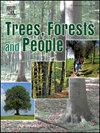Eucalyptus in agrosilvopastoral systems: An alternative for carbon sequestration and the production of roundwood and sawmill timber
IF 2.9
Q1 FORESTRY
引用次数: 0
Abstract
Integrated crop-livestock-forestry systems offer sustainable strategies for mitigating greenhouse gas emissions and enhancing agricultural diversification and intensification, with eucalyptus being the dominant tree component in Brazil. This study aimed to characterise wood quality and carbon stocks in two Eucalyptus genotypes in agrosilvopastoral systems in the Brazilian Cerrado. This research innovates by quantifying wood volume and carbon stock in two integrated systems, thereby providing insights into the key factors that optimize the quality of roundwood timber. Trees of Eucalyptus urograndis and E. cloeziana were monitored throughout their production cycle, and the evaluations for this study were carried out at 120 months after transplanting, prior to timber harvest. Longitudinal discs were removed from six trees per treatment at 2 %, 10 %, 30 %, 50 % and 70 % of the commercial height. We evaluated attributes such as bark content, heartwood to sapwood ratio, pith eccentricity, basic density and carbon content in the wood. To determine carbon stock, a total of 18 trees per treatment were sampled, with three trees selected from each of six diameter classes, representing the lower, middle, and upper diameter ranges, and their volumes were subsequently calculated using the Smalian method. Both genotypes showed wood quality associated with a bark content of <3.5 %, acceptable pith eccentricity below 5 %, heartwood to sapwood ratio greater than one, percentage of heartwood greater than 50 %, and a high basic density of >0.60 g/cm3, ideal indicators for using the wood in sawmills, the construction industry and rural areas. A carbon stock of 50 Mg ha−1 in the stem of E. urograndis, double that E. cloeziana (25 Mg ha−1) indicate a significant capacity for carbon fixation within the wood of this hybrid species in an agrosilvopastoral system in the Brazilian Cerrado biome. Our findings showed that silvicultural practices and eucalyptus genotypes adapted to edaphoclimatic conditions are the key factors for maximizing carbon sequestration and achieving high-quality wood production for construction and sawmills within agrosilvopastoral systems.
复合林系统中的桉树:碳固存和生产圆木和锯木厂木材的替代品
作物-牲畜-林业综合系统为减少温室气体排放和加强农业多样化和集约化提供了可持续战略,桉树是巴西的主要树种。本研究旨在研究巴西塞拉多农林系统中两种桉树基因型的木材质量和碳储量。本研究的创新之处在于将木材体积和碳储量在两个综合系统中量化,从而为优化圆木木材质量的关键因素提供了见解。在整个生产周期内对欧洲大桉树和cloeziana树进行监测,并在移植后120个月,采伐木材之前进行本研究的评估。每次处理分别在商业高度的2%、10%、30%、50%和70%处去除6棵树的纵盘。我们评估了树皮含量、心材与边材比、髓偏心率、基本密度和木材中的碳含量等属性。为了确定碳储量,每个处理共取样18棵树,从6个直径类别中选择3棵树,分别代表低、中、高直径范围,随后使用Smalian方法计算其体积。两种基因型木材的树皮含量均为3.5%,可接受的髓偏心率低于5%,心材与边材比大于1,心材百分比大于50%,基本密度为0.60 g/cm3,是锯木厂、建筑行业和农村地区使用木材的理想指标。在巴西塞拉多生物群系中,欧洲大叶豆茎中的碳储量为50 Mg ha - 1,是cloeziana (25 Mg ha - 1)的两倍,这表明在巴西塞拉多生物群系中,这种杂交物种的木材具有显著的固碳能力。研究结果表明,适应气候条件的造林实践和桉树基因型是农林复合系统中最大限度地实现碳固存和实现建筑和锯木厂高质量木材生产的关键因素。
本文章由计算机程序翻译,如有差异,请以英文原文为准。
求助全文
约1分钟内获得全文
求助全文
来源期刊

Trees, Forests and People
Economics, Econometrics and Finance-Economics, Econometrics and Finance (miscellaneous)
CiteScore
4.30
自引率
7.40%
发文量
172
审稿时长
56 days
 求助内容:
求助内容: 应助结果提醒方式:
应助结果提醒方式:


